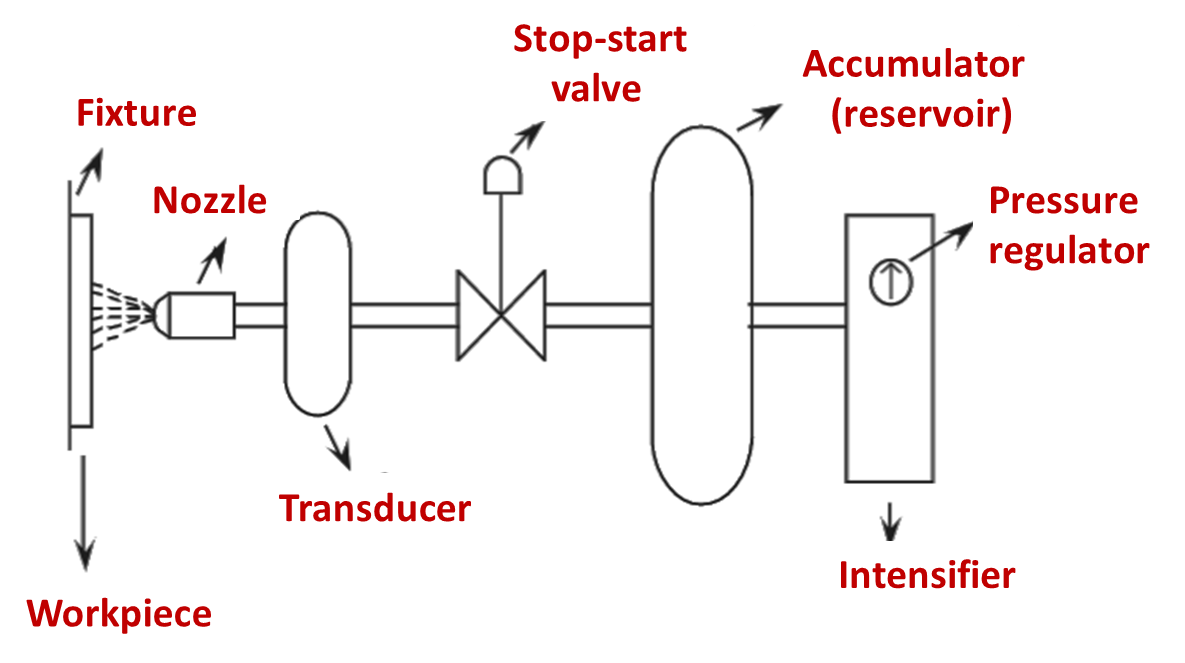
Figure 1: Water Jet Machining.
The above figure 1 shows the setup of equipment for water jet machining. It consists of a hydraulic pump which is driven by an electric motor of about 30 kW. The pump increases the oil pressure upto 117 bar so that it can operate reciprocating plunger pump also known as intensifier. The intensifier plays a significant role in the process. The water enters the intensifier at 4 bar and leaves with high pressure, about 3800 bar. Also, this device helps to maintain continuous flow of high pressure water. This water is then allowed to flow in an accumulator in order to maintain a uniform discharge pressure and velocity of water.
High pressure tubing made of solid stainless steel wall is used to supply water from accumulator to the cutting head. The high pressure liquid (water) is converted to a high velocity jet with the help of a nozzle.
Construction of Water Jet Machining
The water and polymers are mixed uniformly in a mixer. The polymer is used to check the divergence of stream coming from the nozzle. This mixture is sent into the intensifier where the pressure of water is raised. The high pressure water is then supplied to accumulator (reservoir) for storing the energy. During the idle periods, this stored energy is utilised for cutting operations. The high pressure water which is coming from the accumulator is allowed to flow in a nozzle through a stop-start valve. The nozzle helps to convert high pressure water to high velocity jet. This high velocity jet from nozzles are used for cutting operation. The block diagram of water jet machining is shown in the figure 2 below,

Figure 2: Water Jet Machining Diagram.
Factors Affecting the Performance of Water Jet Machining
The factors that affect the performance of Water Jet Machining process are as follows.
- Pressure
- Diameter of nozzle
- Traverse rate
- Stand-off distance.
Pressure
Pressure of water jet plays a significant role in the performance of water jet machining. High pressure of jet is desired for culling the materials at faster rate.
Diameter of Nozzle
It determines the width of cut required on the component. It is also an important factor that affects the performance of Water Jet Machining. Small diameter of jets is preferred for machining small grooves whereas large diameter jets are required for making large grooves.
Traverse Rate
It has great influence on the performance of Water Jet Machining. Deep and wide machining requires low traverse rate, whereas narrow and shallow type of machining prefers high traverse rate. For thick machining purposes, low traverse rate is used.
Stand-off Distance
It is less effective factor on the performance of Water Jet Machining process. It is the distance of the nozzle exit from which the water is injected to the workpiece surface. The cutting is accomplished only if the stand-off distance is less than 25 mm with a tolerance of 3 mm. This distance usually ranges between 3-25 min.
Advantages of Water Jet Machining
- Water is non-toxic, non-flammable, cheap and also it is readily available in nature.
- There is no contact between the tool and workpiece. Thus, mechanical losses are eliminated in the process.
- This method does not generate heat. Hence, the physical properties of work materials remain unchanged.
- The machined workpiece is free from chip or dust formation on the surfaces.
- After cutting operation, the fluid can be reused by filtering the wear particles.
- Contour and complex shapes can be machined easily.
- Wear on the tool is almost negligible.
- It is a noiseless operation.
- Process is free from pollution because all the cuffing residues are carried away by the fluid jet.
- The maintenance required is less due to the absence of moving parts in the method.
- This method is best suited for explosive environment, cuffing asbestos and glass fibre insulation.
Limitations of Water Jet Machining
- High initial cost
- Machining accuracy is poor.
- Hard materials cannot be machined.
- Low material removal rate.
Applications of Water Jet Machining
Water jet machining has wide applications in industries due to the advancement of new equipment’s such as quick acting valves and automatic sensors. The few applications of Water Jet Machining are as follows.
- Water Jet Deburring
Water jets are widely used in industries for removing surface irregularities or burrs. Deburring is achieved by breaking the buns on the workpiece due to the impact of water jet. Plunger pumps are used for removing large burrs since they are capable of producing high pressures upto 1000 bar.
- Water Jet Cutting of Printed Circuit Boards
Norwood and Johnston describes the cutting of Printed Circuit Board (PCB) by water jet machining. This method can cut various shapes of boards which are used in portable radios, cassette players etc.
- Water Jet Cutting of Rock or Coal
In mining industries, the high pressure jet ejected from the nozzle is used for cutting both rock or coal. According to Reichman and Cheung, for cutting a slot of 51 mm deep in granite, they used two 0.3 mm oscillating jets at 275 MPa and reported that the cut was made in 14 passes at a feed rate of 25.4 mm/s.